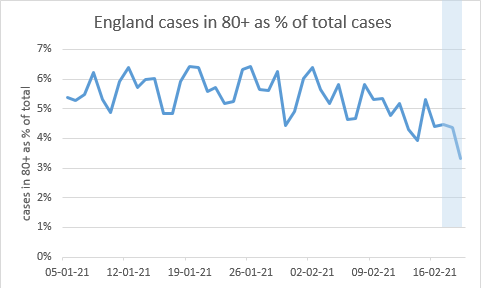
OK, I think I’m ready to call this as a new trend in the 75-79s (cases as a % of total, for England). The timing fits for this to be a vaccine effect; we know vaccination of this group started in earnest from 25th Jan (although some may have had it slightly before then) 1/5 

and the deviation is from 9th Feb i.e. 15 days later. Data from Phase 3 trials and from Israel was suggesting a delay of 14-19 days, perhaps longer in the older age groups. This is the link showing over-70s started booking from Monday 25th Jan: bbc.co.uk/news/uk-556981… 2/5
And this NHS data shows that 83% of 75-79yos were vaccinated by Sunday 31st Jan – so we should be getting the full effect of that over the next few days of data. england.nhs.uk/statistics/wp-…
The effect isn’t as clear yet in the 70-74yos, but that’s not surprising because only 35% of them had been vaccinated by 31st Jan– it looks like most areas went down the age categories in strict order. So we’d be looking for this to move more strongly in the next week. 4/5 

And here’s our old friend the over-80s, continuing its gentle track downwards. (please note as always, data in the blue zone is unreliable / incomplete / subject to revisions) 5/5 

@andrew_lilico @BristOliver (and the bunny): this must be getting close to definitive now?
• • •
Missing some Tweet in this thread? You can try to
force a refresh







